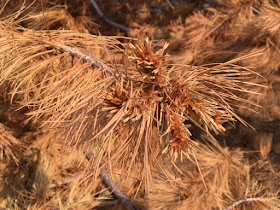 |
| Pumpkin- Johnny's Seed Picture |
 |
| Assorted Gourds- Johhny's Seed picture |
This
is the time of year when we think of adding colorful vegetables to our
table. Among these are ornamental
gourds. They come in all shapes and
sizes with some as small as an egg and others the size of a duck but shaped
like a swan. Some are warty. Some are smooth. Some are striped while others are
speckled. Many can be dried and used to
make crafts or items like birdhouses. If
you like them and have the room, try planting a mixture of gourds next year
after the soil temperatures reach 60 degrees F.
Then
there are pumpkins. My son, a CSU
sophomore, contacted me to ask if he carved a pumpkin, could he still use it to
make pumpkin pie. The answer was NO on
two counts. The first no is due to food
safety conditions. The second no is
because there are different varieties of pumpkins for different uses. Some pumpkins are breed for eating where
others are breed to be a Jack-o-lantern and others like gourds just for
ornamental reasons. Here is a
Ram-o-lantern. If you have a Facebook
account, search for Colostate how to carve a ram-o-lantern and there is a nice
YouTube.
 |
| CSU Ram-o-Lantern |
Today’s pumpkin no longer comes in a smooth textured orange
package. Colors range from white, to
pink to orange to red. There are
striped, speckled and warty pumpkins.
Members of the squash family easily cross giving us all kinds of squash
shapes and sizes. And did you know that
there are male and female flowers? We
also have a native squash bee that will visit and pollinate your plants.
As with any crop, buy certified disease free seed. There are many Colorado seed companies with great seed or national seed companies. Or you can save some seed from your healthy
plants but what you get may be a cross (hybrid). Rotate your crops so the pumpkins and gourds
(all squash) are only in the same place every 4 years and don’t plant too early
in cold soils. It potentially can
setback the plants for the whole season.
Common pumpkin problems include powdery mildew, squash bugs
and critters like deer that like to eat them.
Here is a fact sheet: http://extension.colostate.edu/topic-areas/yard-garden/cucumbers-pumpkins-squash-and-melons-7-609/
And Agriculture info: http://specialtycrops.agsci.colostate.edu/pumpkins/
 |
| Pink Porceline Doll Pumpkin- PinkPumpkinPatch.org |
The main pumpkin season is October and November. Support the pumpkin farmers by using them for
cooking throughout the winter. From pumpkin bread, rolls, soup, eggnog to
coffee, there are lots of pumpkin recipes out there. I always heard to eat all the colors so
pumpkins have orange covered. http://www.liveeatplay.colostate.edu/eat/nutrition101/foods-a-z/pumpkin.php#.WfjqJ1tSw2w
 |
| Pumpkin Pie from GardenPress |
Happy Halloween and Thanksgiving. Give Pumpkins a try.
Susan
Carter is the CSU Extension Horticulture Agent for the Tri River Area.












